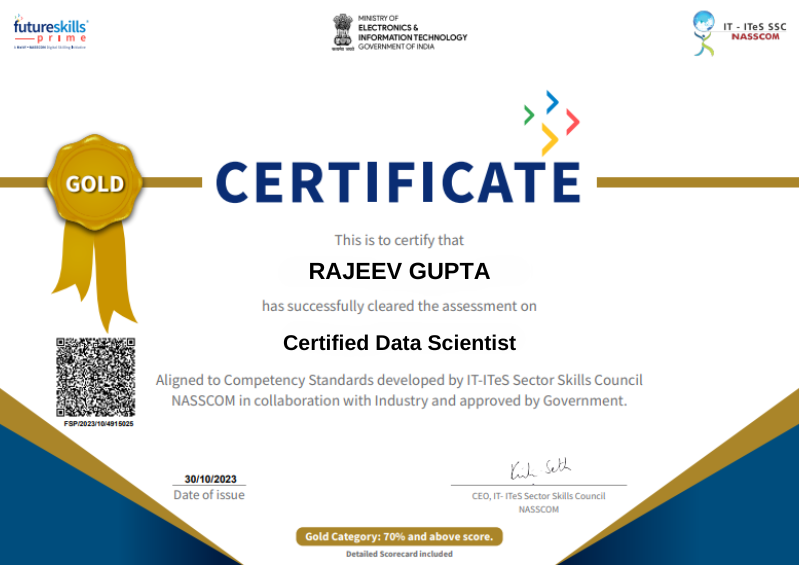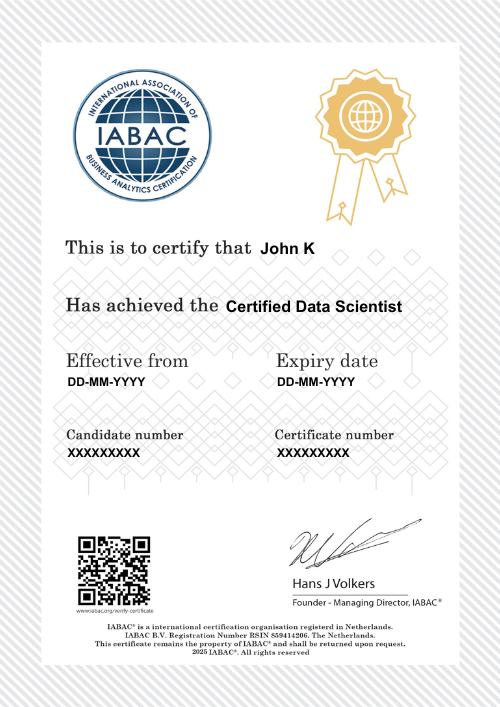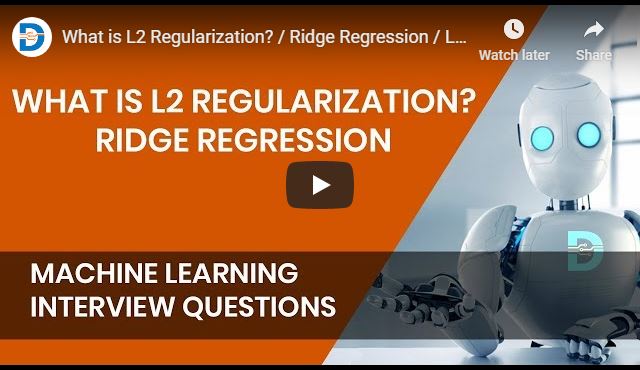Instructor Led Live Online
Self Learning + Live Mentoring
Customize Your Training


MODULE 1: DATA SCIENCE ESSENTIALS
• Introduction to Data Science
• Evolution of Data Science
• Big Data Vs Data Science
• Data Science Terminologies
• Data Science vs AI/Machine Learning
• Data Science vs Analytics
MODULE 2: DATA SCIENCE DEMO
• Business Requirement: Use Case
• Data Preparation
• Machine learning Model building
• Prediction with ML model
• Delivering Business Value.
MODULE 3: ANALYTICS CLASSIFICATION
• Types of Analytics
• Descriptive Analytics
• Diagnostic Analytics
• Predictive Analytics
• Prescriptive Analytics
• EDA and insight gathering demo in Tableau
MODULE 4: DATA SCIENCE AND RELATED FIELDS
• Introduction to AI
• Introduction to Computer Vision
• Introduction to Natural Language Processing
• Introduction to Reinforcement Learning
• Introduction to GAN
• Introduction to Generative Passive Models
MODULE 5: DATA SCIENCE ROLES & WORKFLOW
• Data Science Project workflow
• Roles: Data Engineer, Data Scientist, ML Engineer and MLOps Engineer
• Data Science Project stages.
MODULE 6: MACHINE LEARNING INTRODUCTION
• What Is ML? ML Vs AI
• ML Workflow, Popular ML Algorithms
• Clustering, Classification And Regression
• Supervised Vs Unsupervised
MODULE 7: DATA SCIENCE INDUSTRY APPLICATIONS
• Data Science in Finance and Banking
• Data Science in Retail
• Data Science in Health Care
• Data Science in Logistics and Supply Chain
• Data Science in Technology Industry
• Data Science in Manufacturing
• Data Science in Agriculture
MODULE 1: PYTHON BASICS
• Introduction of python
• Installation of Python and IDE
• Python Variables
• Python basic data types
• Number & Booleans, strings
• Arithmetic Operators
• Comparison Operators
• Assignment Operators
MODULE 2: PYTHON CONTROL STATEMENTS
• IF Conditional statement
• IF-ELSE
• NESTED IF
• Python Loops basics
• WHILE Statement
• FOR statements
• BREAK and CONTINUE statements
MODULE 3: PYTHON DATA STRUCTURES
• Basic data structure in python
• Basics of List
• List: Object, methods
• Tuple: Object, methods
• Sets: Object, methods
• Dictionary: Object, methods
MODULE 4: PYTHON FUNCTIONS
• Functions basics
• Function Parameter passing
• Lambda functions
• Map, reduce, filter functions
MODULE 1: OVERVIEW OF STATISTICS
• Introduction to Statistics
• Descriptive And Inferential Statistics
• Basic Terms Of Statistics
• Types Of Data
MODULE 2: HARNESSING DATA
• Random Sampling
• Sampling With Replacement And Without Replacement
• Cochran's Minimum Sample Size
• Types of Sampling
• Simple Random Sampling
• Stratified Random Sampling
• Cluster Random Sampling
• Systematic Random Sampling
• Multi stage Sampling
• Sampling Error
• Methods Of Collecting Data
MODULE 3: EXPLORATORY DATA ANALYSIS
• Exploratory Data Analysis Introduction
• Measures Of Central Tendencies: Mean,Median And Mode
• Measures Of Central Tendencies: Range, Variance And Standard Deviation
• Data Distribution Plot: Histogram
• Normal Distribution & Properties
• Z Value / Standard Value
• Empirical Rule and Outliers
• Central Limit Theorem
• Normality Testing
• Skewness & Kurtosis
• Measures Of Distance: Euclidean, Manhattan And Minkowski Distance
• Covariance & Correlation
MODULE 4: HYPOTHESIS TESTING
• Hypothesis Testing Introduction
• P- Value, Critical Region
• Types of Hypothesis Testing
• Hypothesis Testing Errors : Type I And Type II
• Two Sample Independent T-test
• Two Sample Relation T-test
• One Way Anova Test
• Application of Hypothesis testing
MODULE 1: MACHINE LEARNING INTRODUCTION
• What Is ML? ML Vs AI
• Clustering, Classification And Regression
• Supervised Vs Unsupervised
MODULE 2: PYTHON NUMPY PACKAGE
• Introduction to Numpy Package
• Array as Data Structure
• Core Numpy functions
• Matrix Operations, Broadcasting in Arrays
MODULE 3: PYTHON PANDAS PACKAGE
• Introduction to Pandas package
• Series in Pandas
• Data Frame in Pandas
• File Reading in Pandas
• Data munging with Pandas
MODULE 4: VISUALIZATION WITH PYTHON - Matplotlib
• Visualization Packages (Matplotlib)
• Components Of A Plot, Sub-Plots
• Basic Plots: Line, Bar, Pie, Scatter
MODULE 5: PYTHON VISUALIZATION PACKAGE - SEABORN
• Seaborn: Basic Plot
• Advanced Python Data Visualizations
MODULE 6: ML ALGO: LINEAR REGRESSSION
• Introduction to Linear Regression
• How it works: Regression and Best Fit Line
• Modeling and Evaluation in Python
MODULE 7: ML ALGO: LOGISTIC REGRESSION
• Introduction to Logistic Regression
• How it works: Classification & Sigmoid Curve
• Modeling and Evaluation in Python
MODULE 8: ML ALGO: K MEANS CLUSTERING
• Understanding Clustering (Unsupervised)
• K Means Algorithm
• How it works : K Means theory
• Modeling in Python
MODULE 9: ML ALGO: KNN
• Introduction to KNN
• How It Works: Nearest Neighbor Concept
• Modeling and Evaluation in Python
MODULE 1: FEATURE ENGINEERING
• Introduction to Feature Engineering
• Feature Engineering Techniques: Encoding, Scaling, Data Transformation
• Handling Missing values, handling outliers
• Creation of Pipeline
• Use case for feature engineering
MODULE 2: ML ALGO: SUPPORT VECTOR MACHINE (SVM)
• Introduction to SVM
• How It Works: SVM Concept, Kernel Trick
• Modeling and Evaluation of SVM in Python
MODULE 3: PRINCIPAL COMPONENT ANALYSIS (PCA)
• Building Blocks Of PCA
• How it works: Finding Principal Components
• Modeling PCA in Python
MODULE 4: ML ALGO: DECISION TREE
• Introduction to Decision Tree & Random Forest
• How it works
• Modeling and Evaluation in Python
MODULE 5: ENSEMBLE TECHNIQUES - BAGGING
• Introduction to Ensemble technique
• Bagging and How it works
• Modeling and Evaluation in Python
MODULE 6: ML ALGO: NAÏVE BAYES
• Introduction to Naive Bayes
• How it works: Bayes' Theorem
• Naive Bayes For Text Classification
• Modeling and Evaluation in Python
MODULE 7: GRADIENT BOOSTING, XGBOOST
• Introduction to Boosting and XGBoost
• How it works?
• Modeling and Evaluation of in Python
MODULE 1: TIME SERIES FORECASTING - ARIMA
• What is Time Series?
• Trend, Seasonality, cyclical and random
• Stationarity of Time Series
• Autoregressive Model (AR)
• Moving Average Model (MA)
• ARIMA Model
• Autocorrelation and AIC
• Time Series Analysis in Python
MODULE 2: SENTIMENT ANALYSIS
• Introduction to Sentiment Analysis
• NLTK Package
• Case study: Sentiment Analysis on Movie Reviews
MODULE 3: REGULAR EXPRESSIONS WITH PYTHON
• Regex Introduction
• Regex codes
• Text extraction with Python Regex
MODULE 4: ML MODEL DEPLOYMENT WITH FLASK
• Introduction to Flask
• URL and App routing
• Flask application – ML Model deployment
MODULE 5: ADVANCED DATA ANALYSIS WITH MS EXCEL
• MS Excel core Functions
• Advanced Functions (VLOOKUP, INDIRECT..)
• Linear Regression with EXCEL
• Data Table
• Goal Seek Analysis
• Pivot Table
• Solving Data Equation with EXCEL
MODULE 6: AWS CLOUD FOR DATA SCIENCE
• Introduction of cloud
• Difference between GCC, Azure, AWS
• AWS Service ( EC2 instance)
MODULE 7: AZURE FOR DATA SCIENCE
• Introduction to AZURE ML studio
• Data Pipeline
• ML modeling with Azure
MODULE 8: INTRODUCTION TO DEEP LEARNING
• Introduction to Artificial Neural Network, Architecture
• Artificial Neural Network in Python
• Introduction to Convolutional Neural Network, Architecture
• Convolutional Neural Network in Python
MODULE 1: DATABASE INTRODUCTION
• DATABASE Overview
• Key concepts of database management
• Relational Database Management System
• CRUD operations
MODULE 2: SQL BASICS
• Introduction to Databases
• Introduction to SQL
• SQL Commands
• MY SQL workbench installation
MODULE 3: DATA TYPES AND CONSTRAINTS
• Numeric, Character, date time data type
• Primary key, Foreign key, Not null
• Unique, Check, default, Auto increment
MODULE 4: DATABASES AND TABLES (MySQL)
• Create database
• Delete database
• Show and use databases
• Create table, Rename table
• Delete table, Delete table records
• Create new table from existing data types
• Insert into, Update records
• Alter table
MODULE 5: SQL JOINS
• Inner Join, Outer Join
• Left Join, Right Join
• Self Join, Cross join
• Windows function: Over, Partition, Rank
MODULE 6: SQL COMMANDS AND CLAUSES
• Select, Select distinct
• Aliases, Where clause
• Relational operators, Logical
• Between, Order by, In
• Like, Limit, null/not null, group by
• Having, Sub queries
MODULE 7 : DOCUMENT DB/NO-SQL DB
• Introduction of Document DB
• Document DB vs SQL DB
• Popular Document DBs
• MongoDB basics
• Data format and Key methods
MODULE 1: GIT INTRODUCTION
• Purpose of Version Control
• Popular Version control tools
• Git Distribution Version Control
• Terminologies
• Git Workflow
• Git Architecture
MODULE 2: GIT REPOSITORY and GitHub
• Git Repo Introduction
• Create New Repo with Init command
• Git Essentials: Copy & User Setup
• Mastering Git and GitHub
MODULE 3: COMMITS, PULL, FETCH AND PUSH
• Code Commits
• Pull, Fetch and Conflicts resolution
• Pushing to Remote Repo
MODULE 4: TAGGING, BRANCHING AND MERGING
• Organize code with branches
• Checkout branch
• Merge branches
• Editing Commits
• Commit command Amend flag
• Git reset and revert
MODULE 5: GIT WITH GITHUB AND BITBUCKET
• Creating GitHub Account
• Local and Remote Repo
• Collaborating with other developers
MODULE 1: BIG DATA INTRODUCTION
• Big Data Overview
• Five Vs of Big Data
• What is Big Data and Hadoop
• Introduction to Hadoop
• Components of Hadoop Ecosystem
• Big Data Analytics Introduction
MODULE 2 : HDFS AND MAP REDUCE
• HDFS – Big Data Storage
• Distributed Processing with Map Reduce
• Mapping and reducing stages concepts
• Key Terms: Output Format, Partitioners,
• Combiners, Shuffle, and Sort
MODULE 3: PYSPARK FOUNDATION
• PySpark Introduction
• Spark Configuration
• Resilient distributed datasets (RDD)
• Working with RDDs in PySpark
• Aggregating Data with Pair RDDs
MODULE 4: SPARK SQL and HADOOP HIVE
• Introducing Spark SQL
• Spark SQL vs Hadoop Hive
MODULE 1: TABLEAU FUNDAMENTALS
• Introduction to Business Intelligence & Introduction to Tableau
• Interface Tour, Data visualization: Pie chart, Column chart, Bar chart.
• Bar chart, Tree Map, Line Chart
• Area chart, Combination Charts, Map
• Dashboards creation, Quick Filters
• Create Table Calculations
• Create Calculated Fields
• Create Custom Hierarchies
MODULE 2: POWER-BI BASICS
• Power BI Introduction
• Basics Visualizations
• Dashboard Creation
• Basic Data Cleaning
• Basic DAX FUNCTION
MODULE 3 : DATA TRANSFORMATION TECHNIQUES
• Exploring Query Editor
• Data Cleansing and Manipulation:
• Creating Our Initial Project File
• Connecting to Our Data Source
• Editing Rows
• Changing Data Types
• Replacing Values
MODULE 4: CONNECTING TO VARIOUS DATA SOURCES
• Connecting to a CSV File
• Connecting to a Webpage
• Extracting Characters
• Splitting and Merging Columns
• Creating Conditional Columns
• Creating Columns from Examples
• Create Data Model
Data Science is the discipline dedicated to extracting insights and knowledge from data, employing methods such as statistics, machine learning, and data analysis.
Data Science operates by gathering, processing, and analyzing extensive datasets to reveal meaningful patterns, facilitating informed decision-making across diverse industries.
Practical applications of Data Science include predictive modeling, machine learning, and data-driven decision-making in sectors like healthcare, finance, marketing, and more.
Key components of a Data Science pipeline encompass data collection, preprocessing, exploratory data analysis, feature engineering, model training, evaluation, and deployment.
Big Data is intricately linked to Data Science, dealing with large and complex datasets requiring specialized tools and techniques for thorough analysis.
Data Science finds widespread applications across various industries, including healthcare for predictive analytics, finance for risk assessment, and e-commerce for personalized recommendations.
A career in Data Science often requires an educational background in computer science, statistics, or related fields, coupled with expertise in programming and data manipulation.
Essential skills for a Data Scientist include proficiency in programming, statistical analysis, machine learning, and effective communication.
Building a robust Data Science portfolio involves showcasing projects that demonstrate practical application of skills, problem-solving, and creative thinking.
Industries actively seeking Data Scientists include technology, finance, healthcare, and e-commerce.
Emerging trends in Data Science encompass explainable AI, automated machine learning, and the integration of data ethics.
The data science job market in Mexico in 2024 is shaped by industry demand and technological advancements.
Recognized as a leading choice for data science training in Mexico, the Certified Data Scientist Course covers crucial topics such as machine learning and data analysis.
Data science internships in Mexico can provide significant value by offering practical experience and opportunities for networking.
Freshers can feasibly pursue a data science course and secure employment in Mexico by building a strong skill set and incorporating relevant projects into their portfolio.
Mexico businesses harness data science for growth by utilizing analytics to gain customer insights, optimizing processes, and making strategic decisions.
In finance, data science applications encompass fraud detection, risk assessment, and algorithmic trading.
Data science contributes to e-commerce by powering recommendation systems, personalizing user experiences, and optimizing supply chain management.
In cybersecurity, data science plays a crucial role in detecting anomalies, identifying potential threats, and enhancing overall security measures.
In manufacturing and supply chain management, data science is applied for demand forecasting, inventory optimization, and improving process efficiency.
The salary of a data scientist in Mexico ranges from MXN 81,011 per year according to a Glassdoor report.
The Datamites™ Certified Data Scientist course offers a comprehensive curriculum covering key aspects of data science, including programming, statistics, machine learning, and business knowledge. It emphasizes Python as the primary language and includes R for those familiar. Completion of the course leads to the prestigious IABAC™ certificate.
While beneficial, a statistical background is not always a prerequisite for a data science career in Mexico. Proficiency in relevant tools, programming languages, and practical problem-solving skills are often prioritized.
DataMites in Mexico provides various data science certifications, including a Diploma in Data Science, Certified Data Scientist, Data Science for Managers, Data Science Associate, Statistics for Data Science, Python for Data Science, and specialized certifications in Marketing, Operations, Finance, and HR.
Beginners in Mexico can explore foundational training options such as Certified Data Scientist, Data Science Foundation, and Diploma in Data Science for a solid introduction to data science.
Yes, DataMites in Mexico offers courses tailored for professionals, including Statistics for Data Science, Data Science with R Programming, Python for Data Science, Data Science Associate, and specialized certifications in Operations, Marketing, HR, and Finance.
The data science course in Mexico offered by DataMites has a duration of 8 months.
Career mentoring sessions at DataMites are interactive, providing personalized guidance on resume building, interview preparation, and career strategies to enrich participants' professional journeys in data science.
Upon completing DataMites' Data Science Training in Mexico, participants receive the prestigious IABAC Certification, globally recognized as evidence of their competence in data science concepts and practical applications.
To excel in data science training in Mexico, individuals should establish a solid foundation in mathematics, statistics, and programming. Developing strong analytical skills, proficiency in languages like Python or R, and hands-on experience with tools like Hadoop or SQL databases is recommended.
Opting for online data science training in Mexico from DataMites provides flexibility, accessibility, a comprehensive curriculum aligned with industry needs, industry-relevant content, experienced instructors, interactive learning, and the ability to learn at one's own pace.
The data science training fee in Mexico ranges from MXN 9,148 to MXN 22,873 depending on the specific program.
Certainly, DataMites offers a Data Scientist Course in Mexico, incorporating practical learning with over 10 capstone projects and a dedicated client/live project for hands-on experience and real-world applications.
Trainers at DataMites are chosen based on certifications, extensive industry experience, and expertise in the subject matter.
DataMites offers flexible learning methods, including Live Online data science training in Mexico and self-study, tailored to participants' preferences.
The FLEXI-PASS option in DataMites' Certified Data Scientist Course allows participants to join multiple batches, enabling them to review topics, address doubts, and solidify comprehension across various sessions for a comprehensive understanding of the course content.
Certainly, upon successful completion of DataMites' Data Science Course, participants can obtain a Certificate of Completion by requesting it through the online portal. This certification serves as validation of their proficiency in data science, enhancing their credibility in the job market.
Yes, participants must bring a valid Photo ID Proof, such as a National ID card or Driving License, to obtain a Participation Certificate and schedule the certification exam as needed.
In case of a missed session in the DataMites Certified Data Scientist Course in Mexico, participants usually have the option to access recorded sessions or attend support sessions to make up for missed content and clarify doubts.
Yes, potential participants at DataMites can attend a demo class before making any payment for the Certified Data Scientist Course in Mexico to assess the teaching style, course content, and overall structure.
Yes, DataMites incorporates internships into its certified data scientist course in Mexico, providing a unique learning experience that combines theoretical knowledge with practical industry exposure, enhancing skills and job opportunities in the dynamic field of data science.
Yes, upon completing the Data Science training, you will be granted an internationally recognized IABAC® certification. This certification confirms your proficiency in the field and elevates your employability on a global level.
The DataMites Placement Assistance Team(PAT) facilitates the aspirants in taking all the necessary steps in starting their career in Data Science. Some of the services provided by PAT are: -
The DataMites Placement Assistance Team(PAT) conducts sessions on career mentoring for the aspirants with a view of helping them realize the purpose they have to serve when they step into the corporate world. The students are guided by industry experts about the various possibilities in the Data Science career, this will help the aspirants to draw a clear picture of the career options available. Also, they will be made knowledgeable about the various obstacles they are likely to face as a fresher in the field, and how they can tackle.
No, PAT does not promise a job, but it helps the aspirants to build the required potential needed in landing a career. The aspirants can capitalize on the acquired skills, in the long run, to a successful career in Data Science.









